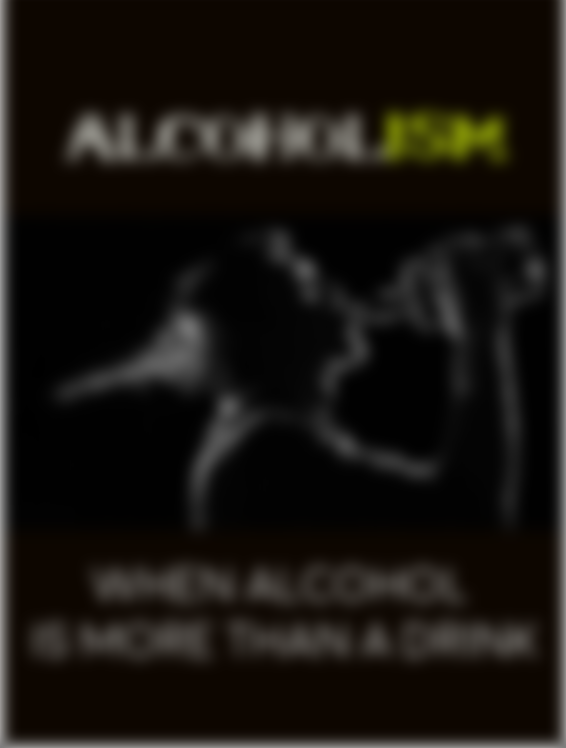
Addiction diseases involve the use of all psychoactive substances that are toxic to the body and psyche, and when continued, they can create the need for their constant intake and thus lead to health, social, economic and safety problems of individuals and society as a whole. One of the most common addictions is alcoholism. Alcoholism - a chronic, progressive, physical, mental and social disease that occurs through uncontrolled and regular use of alcoholic beverages in unlimited quantities and requires professional help.
The causes of alcoholism are: 1. biological (genetic predispositions)
2. psychological (dissatisfaction, difficult childhood, escape from problems, seeking solace, habit )
3. social (financial, social, family, professional problems )
4. wide representation and fast actio
The consequences of alcoholism are: 1. family (poverty, violence, intolerance towards other members and family breakdown )
2. psychological (depression, “delirium tremens”, changes in behavior)
3. professional (reduces efficiency at work, increases the number of injuries at
work )
4. physical (affects the development of various diseases in the body)
5. anti-socialbehavior (crimes, crime, violence )

When it comes to alcohol, its use began quite by accident and has followed man throughout history. After tasting the rotten fruit, the man felt the pleasant effects of relaxation and began to leave the fruit in earthenware containers and through the fermentation process to obtain alcoholic beverages. Alcohol was considered a gift from God that has its role in the fight against unknown forces, adversities and diseases, however, its harmful effects have been noticed since ancient times. As a result of recognizing the negative impact of alcohol, various drinking bans have appeared for certain individuals or in certain situations.
The Imfluence of Alcoholism on Safety

Alcoholism is one of the three biggest addiction diseases, along with drug addiction and nicotine addiction. Alcoholism is the most widespread addiction (10-15% of the adult population) and significantly affects the increased mortality of the population. Alcohol severely impairs both physical and mental health, and shortens life by up to 15 years. Life expectancy due to alcoholism is reduced to 55 to 60 years (for the average untreated alcoholic). When the consequences are added to all this due to traffic accidents in an alcoholic state, as well as due to fights and other types, even more severe aggression under the influence of alcohol, the picture becomes even more difficult.
Influence of alcohol in traffic

One of the most important factors that currently affect the psychophysical ability of drivers is alcohol. Like most other narcotics, alcohol leads to excitement and then to paralysis of the nervous system. This results in a reduction of attention, because an alcoholic driver is dangerous and incapable of normal participation in traffic.
Alcohol in drivers: prolongs reaction time (most often braking); narrows the field of view; significantly reduces hearing; it gives him a sense of omnipotence behind the wheel, which is why he often drives risky.
Drivers under the influence of alcohol usually make the following mistakes: improper bypassing and overtaking, disrespecting the right of way, improper speed, improper passing, later react to light and sound signals, more difficult to recognize red and green, more difficult to recognize interference at night and at dusk, often instead of braking, they press the accelerator pedal or vice versa, they are uncritical, self-confident, frivolous, overestimate their abilities, underestimate danger, etc.
These are all real risks for the occurrence of traffic accidents with tragic consequences. According to the valid regulations, the allowed amount of alcohol in the blood of drivers in Serbia is 0.5 ‰, while for professional drivers it is 0 ‰. Drunk drivers cause about 20% of all traffic accidents. There are three times more serious bodily injuries and deaths in these accidents than in sober drivers.
The impact of alcohol on crime

The link between alcoholism and crime has long been known. According to statistics, the perpetrators of 50% - 60% of all criminal acts are alcoholics. The most common forms of criminal behavior related to alcoholism are: theft; aggressive and violent behavior; sexual offenses; severe bodily injury; murder and juvenile delinquency. Nearly 50% of murderers and rapists were under the influence of alcohol at the time of the crime. About 50% of domestic violence is committed by alcoholic husbands. In 90% of hooliganism on the streets, the cause is alcohol. According to the above, it can be concluded that alcoholism together with crime significantly affects the security of society.
The impact of alcoholism on the family

Alcoholism not only destroys the alcoholic and pushes him to the bottom, it also affects his entire family, so that over time it becomes completely dysfunctional.
In an alcoholic family, even minor crises and problems can lead to a complete blockade of its functioning. Defending against decay, a dysfunctional family produces a symptom (disease) in one of its members. It is paradoxical, but it is precisely this disease that is the factor that keeps the family together in the disease balance, which has an impact on all members. However, over time, there is more and more intense drinking and more frequent excesses, which lead to fierce quarrels in which the whole family participates. Usually it is the spouse who tries to take control while the children withdraw into themselves and live in constant fear.
Alcoholism of her family member inevitably creates family consequences and disrupts: communications, emotional and sexual relations, family roles, financial situation in the family, as well as social ties with relatives and friends. With its destructive effects, alcoholism often leads to divorce and the breakdown of entire families. In addition to everything, alcohol causes sick jealousy, the main characteristic of which is the constant suspicion of infidelity and the search for evidence that would confirm it. This condition can lead to violent behavior and, unfortunately, the murder of a spouse.
At the social level, alcoholism is a bad model and a wrong example that must not be tolerated. Domestic violence often occurs in alcoholic families. Children from alcoholic families have mental disorders, problems at school and problems with social adjustment.
The influence of alcoholism on the attitude towards work

The consequences in relation to which they are served: - dismissal from work, - frequent sick leave, - injuries at work and - disability. An alcoholic is absent from work for 2 months or 10 years for the entire working life. 15% of the men on the disability commission are alcohol addicts, and since then 20% of them have received a category 1 disability. Alcoholics are harmed three times at work by the healthy. Consequences related to alcoholic behavior at work are manifested as: - loss of interest in the job - changed the mood at work - tendency to criticize and oppose - confronting colleagues and superiors at work - blaming others - frequent interpersonal conflicts

The state, as a social and political organization, has the primary task of preserving its security, that is, the security of society, and in that sense it bears the greatest responsibility.
When it comes to alcoholism, the analyzed results of the research speak in favor of the fact that alcoholism has taken the form of an epidemic and appears as a cause of death in an extremely large number of cases, and also affects the occurrence of various diseases, diseases and injuries. From the aspect of the safety of the state and society, a particularly important issue is endangering the safety of public traffic by driving under the influence of alcohol, which directly endangers not only the life of an alcoholic, but also other participants in traffic.The negative consequences of alcohol consumption are also reflected in the psychological state that alcohol causes, which can contribute to the occurrence of delinquent behavior, neglect of the family, social exclusion, reduced work ability, etc. Thus, alcoholism is a widespread socio-pathological phenomenon, the consequences of which are evident and known, but its strong destructive impact on the security of the state and society, which imposes the need to improve and create more effective prevention measures, has not been recognized.








Ok mam...carry on..we are with u